NATURAL ENERGY SOURCES
- GOAL:
- To learn the different energy sources and to distinguish between renewable and nonrenewable resources.
- OBJECTIVE:
- The student will:
- (1) Recognize different energy sources.
- (2) Be able to associate everyday energy use with the original sources.
- (3) Know the energy sources and explain why some sources are renewable and some are nonrenewable.
- LESSON / INFORMATION:
- Energy
- Energy is the capacity to do work. The unit of energy most often used in this country is the Btu (British Thermal Unit). The unit measure of electricity is the kilowatt hour (kWh), which is about equivalent to 3,412 Btu's. The unit measure of natural gas is the cubic foot (CF) which is about equivalent to 1000 Btu's.
- Energy can be in the form of thermal, radiant, electrical, mechanical, chemical, and atomic energy. The first two come directly from the sun, the second two come indirectly from the sun, and the last two are independent from the sun.
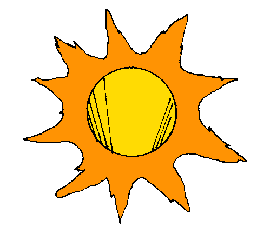

- Historically, man first had himself and the sun to provide energy. He used himself to do any work and relied on the sun for a source of light and heat. Fire was the first usable energy discovery, and animals began to share some of the work. The use of coal to produce steam was a major breakthrough in man's development along with the industrial revolution - the age of the machine to do the work. Oil and gas were an improvement over coal to run the machine man used to do work.
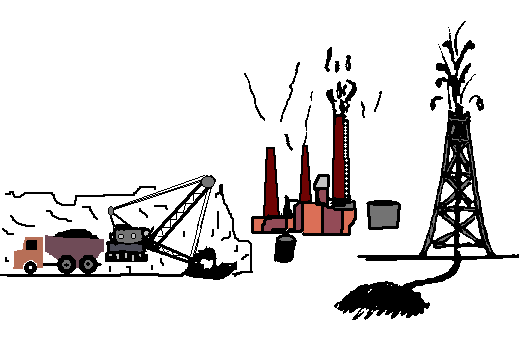
- Then nuclear energy was developed. It was supposed to be "too cheap to meter," and the hazardous waste problem would be solved in a "few short years."
- Nuclear energy is heat created by fission which is the splitting of atoms or by fusion where two atoms are fused together. The heat in the sun is from fusion. This form of energy is still experimental on Earth, but nuclear fission has been around since World War II. Nuclear fission has a by-product of radioactive waste that will last for 500,000 years. In other words, if Neanderthal Man had used fission, we would be burdened with his radioactive waste even today.
- NATURAL ENERGY RESOURCES
- Energy is all around us and manifests itself in many different forms -- heat, light, sound, magnetism, gravity, movement, and all life functions. It is everywhere in great abundance. Since the beginning of time, nature has been producing and reproducing energy in quantities so astronomical that we could never begin to use it all, not even with the most advanced technology.
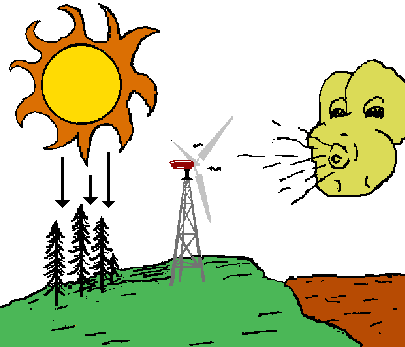
- Most energy sources are ongoing or renewable while others are finite. Ironically, we have chosen to produce appreciable energy from only one source, fossil fuels. A small fraction of one percent of the sun's energy that the Earth absorbs is converted into plant tissue, and it is this tiny fraction that has produced all fossil fuels. Fossil fuels are usually environmentally destructive in their harvesting and in their burning to produce usable energy. They are nonrenewable. When they are used up, they are gone forever. It will take thousands of years for the Earth to reproduce fossil fuels already used.
- Renewable energy sources come from the fact that the Earth is a living organism. All of these resources are available on a daily or seasonable basis. The natural and renewable energy systems of the Earth that are useful in the design of our buildings can be divided into sun, wind, water, earth and plants.
- Sun
- Our sun is a star -- that is, its light is internally produced, rather than reflected. It is our life source, a source of light and heat. It is received by the Earth through radiation. The following are possible natural uses of the sun:
- Thermal Heat can be used for passive heating of buildings and water.
- Ventilation can be induced by the "chimney" or "stack" effect.
- Shading is the blocking of the direct sun, and one of the most important elements for natural cooling in Louisiana.
- Radiant Cooling is the absence of the sun and exposure to clear deep outer space at night.
- Daylight - use of natural light can contribute immensely to the reduction of artificial light needed to light your building.
- Photo-chemical reactions from the sun by plants, animals, and materials create changes in color, form, and growth. A greenhouse can provide food and heat.
- Electrical power is obtained directly from the sun with photovoltaic cells, a potential that becomes more feasible every day.
- Humidification is provided by using the sun's energy to evaporate water. One of Louisiana's major comfort problems is the high moisture already in the air.
- Wind
- The unequal distribution of radiant heat from the sun on the surface of the Earth produces variations in heat contents of the air mass with corresponding variations in its density. These variations cause air movement, which is modified by the Earth's rotation, inclination, uneven distribution of land and ocean masses, and geographic abnormalities. This flow of air is called wind.

- The wind can be used in many passive ways. The following are examples:
- Cooling is accomplished by the ability of the wind to remove or relocate heat from an object. The rate at which heat is removed is proportional to the velocity of the air.
- Combustion air is required for fire. Fire is easily adjusted by controlling fresh air intake.
- Pumping water by windmills was familiar to rural Americans early in this century.
- Water
- About three-fourths of the Earth's surface is water. The natural cycle of water evaporation and precipitation created by the sun is a force needed to sustain life on Earth. Many forms of energy can be realized from this movement of water in its natural cycle. Below are a few examples:

- Electrical energy can be generated by the movement of water in different ways.
- Hydro-Electric Dams hold water above its natural level creating a head pressure needed to power generators.
- Turbines have been designed to take advantage of the Mississippi River and the Gulf Stream.
- Ocean Thermal gradients are the temperature difference between surface and deep waters. In some parts of the world, heat engines can be powered this way.
- Tidal power can harness ocean movement resulting from gravitational forces of the moon. Dams can trap water to be released through turbines. Turbines that take advantage of water movement in both directions are more efficient.
- Cooling with water is possible by exposing it to the clear night sky where heat is given up by radiation. Ponds on flat roofs are used in this manner. Heat can also be lost through evaporation. Water sprayed on roofs is beneficial even in humid areas, but more efficient in arid areas. Caution should be used in areas of scarce water or drainage problems.
- Thermal Inertia is the stabilizing of temperatures by a large body of water. Coastal, riverfront, and lakefront cities are known for their milder climates and refreshing breezes. The wind movement is generated by the temperature difference from water to land. The temperature difference between day and night is much greater on land than over water. That is one reason why Alexandria is warmer in the summer and colder in the winter than New Orleans.
- Thermal Storage by water is four times the capacity of concrete, brick or gravel. Each gallon of water can hold 660 Btus of thermal energy. The heat in water is fairly evenly distributed by convection.
- Cleaning water takes place through its movement. This movement causes it to drop the heavier impurities and gives it greater exposure to the sun and air. Algae and micro-organisms which live in the water also help to clean it.
- Plants need water as part of their food supply. Water can be retained in cisterns or ponds for landscaping and greenhouse use.
- Conservation of water is important because it takes more and more energy to clean water and move it to your building.
- Recycling of a fixed supply of water on, in, and around the Earth is a natural system. It can change states from solid to liquid to gas. Gray water from your building can be reused before disposal.
- Earth
- Earth is an almost spherical body approximately 4,000 miles in radius. The center is occupied by a hot core 2,200 miles in radius which is surrounded by the 1,800 mile thick mantle. The outer crust is only 5 to 25 miles thick. It is within a few inches above and below the ground surface that earth, air, and water mix in the presence of sunlight. Here phenomena or processes of chemistry, osmosis, transpiration, decay, transmutation, and regeneration take place. We are absolutely dependent upon the workings within this fragile matrix.
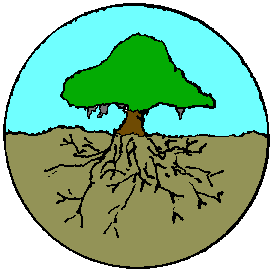
- Fossil Fuels are formed and contained in the earth. They are a valuable energy source which is renewable only on an extremely protracted time scale measured in millions of years.
- Cooling and Heating can be used by the thermal lag between surface temperatures and those below ground. At a depth of 15 feet below ground, the temperatures will be about three months behind the surface temperatures. In Lafayette, the average yearly deep ground temperature is around 68°F in the summer to 71°F in the winter.
- Insulation value can be given to the earth by tempering heat gains or losses through roofs, walls, and floors. Water pipes in the ground below the frost line are protected from freezing temperatures. Earth forms can be designed to protect buildings from wind and other harsh weather conditions, or they can be formed to channel air into the building.
- Geothermal energy is provided by subterranean movement of water in contact with the intense heat produced at the Earth's core. This source can provide steam and hot water.
- Geopressure can be found deep in the ground. This pressure can move turbines to produce mechanical or electrical energy.
- Purification of water occurs as it percolates down through the soil where impurities are deposited. This process is aided by aerobic and anaerobic bacteria in the soil that over time reduce most waste to a harmless state.
- Building Materials can be obtained from the Earth at the site without or with less of the expense of manufacturing and transporting them. Stabilized earth, adobe blocks, rammed earth, earth floors, sod roofs, and mud surfacing are examples of on site, low cost building material potentials.
- Vegetation
- It is important to understand the value of plant life on Earth. (It is interesting that words plant and planet are so much alike.) Photosynthesis takes place in the chlorophyll cells of green plants -- consuming carbon dioxide, producing carbohydrates, and freeing oxygen. This relationship of sun and plants that created the biosphere around the Earth allows man and animals to survive. Biomass is the plant and animal material produced by photochemical reaction.
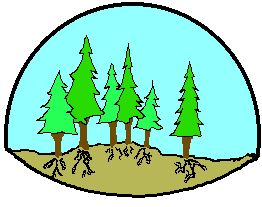
- Fire, Heat and Light are the release of the sun's energy (used in creating the wood) when wood is burned. Free oxygen is added back by the chemical process during combustion. Chemically, a wood fire is the reversal of nature's growth process but at a much greater speed. Care must be taken to provide complete combustion, otherwise pollutants will be released into the air.
- Methane is a colorless, odorless, flammable gas which is formed by the decomposition of organic waste products of living organisms on Earth. Methane, the main component of natural gas, can be used as a heating fuel and for illumination. In addition, its by-product can be used as fertilizer.
- Alcohol can be obtained by a fermentation process producing Ethanol or by a distillation process creating Methanol.
- Insulation in the form of cellulose is a wood product made from recycled newspapers. Vegetation used as a wind break helps the insulation properties of a building.
- Purification of the air is probably the greatest asset of plant life along with food, which nourishes and sustains life.
- RECOMMENDED READING:
- Cazayoux, E., A. Hebert & D. Winn, Natural Louisiana Architecture, Designing for Comfort and Energy, Dept. of Natural Resources, Baton Rouge, Louisiana, 1991.
- ACTIVITY 1:
- Directions: The student should read the material and locate on the letter matrix, the energy sources that are in bold italics.
- Letter Matrix:
- *****Pick here for Letter Matrix*****
- INFORMATION CHECK
- 1. Energy can be in the form of ______________, _______________, ___________________, ___________________, _________________ and __________________ energy.
- 2. Define nuclear energy.
- ______________________________________________________________
- _____________________________________________________________.
- 3. The sun is a renewable energy source. List examples of the possible natural uses of the sun.
- ______________________________________________________________
- ______________________________________________________________
- ______________________________________________________________
- ______________________________________________________________
- 4. Wind can be used in many passive ways. List examples below:
- ______________________________________________________________
- ______________________________________________________________
- ______________________________________________________________
- ______________________________________________________________
- 5. Water covers approximately three-fourths of the Earth's surface. List examples of the forms of energy that can be realized from the movement of water.
- ______________________________________________________________
- ______________________________________________________________
- ______________________________________________________________
- ______________________________________________________________
- 6. _________________ is the plant and animal material produced by photochemical reaction.
- 7. __________________________________ is probably the greatest asset of plant life along with food, which nourishes and sustains life.
- 8. The unit of measure of electricity is the ____________________ which is equivalent to _________________ Btus.
- 9. Why is Alexandria, Louisiana, warmer in the summer and colder in the winter than New Orleans, Louisiana?
- ______________________________________________________________
- ______________________________________________________________
- ______________________________________________________________
- ______________________________________________________________
- 10. ___________________ are a valuable energy source which is renewable only on an extremely protracted time scale measured in millions of years.
- TEACHER'S NOTES
- Answer to Letter Matrix:
- *****Pick here for Letter Matrix Answers*****
- Answers to Information Check:
- 1. Thermal, radiant, electrical, mechanical, chemical and atomic energy.
- 2. Nuclear energy is heat created by fission which is the splitting of atoms or by fusion where two atoms are fused together.
- 3. Thermal heat, ventilation, shading, daylight, photo-chemical reactions from the sun by plants, animals, and materials that create changes in color, form, and growth; photovoltaic cells create electrical power, and humidification by the sun's evaporation of water.
- 4. Cooling is accomplished by the ability of the wind to remove or relocate heat from an object, combustion air is required for fire, and pumping water by windmills.
- 5. Hydroelectric dams, turbines designed to take advantage of the Mississippi River and the Gulf Stream, tidal power, ocean thermal gradients, cooling with water by exposing it to clear night sky, thermal inertia, thermal storage by water, and watering of plants.
- 6. Biomass.
- 7. Purification of the air.
- 8. kilowatt hour, equivalent to 3,412 Btus.
- 9. Coastal, riverfront and lakefront cities, such as New Orleans, are known for their milder climates and refreshing breezes. The wind movement is generated by the temperature difference from water to land. The temperature difference between day and night is much greater on land than over water. Therefore, since Alexandria is not near any large body of water, it is warmer in the summer and colder in the winter than New Orleans.
- 10. Fossil fuels.
Comments or questions to: TechAsmt@LA.GOV
Return to Home Energy Menu










